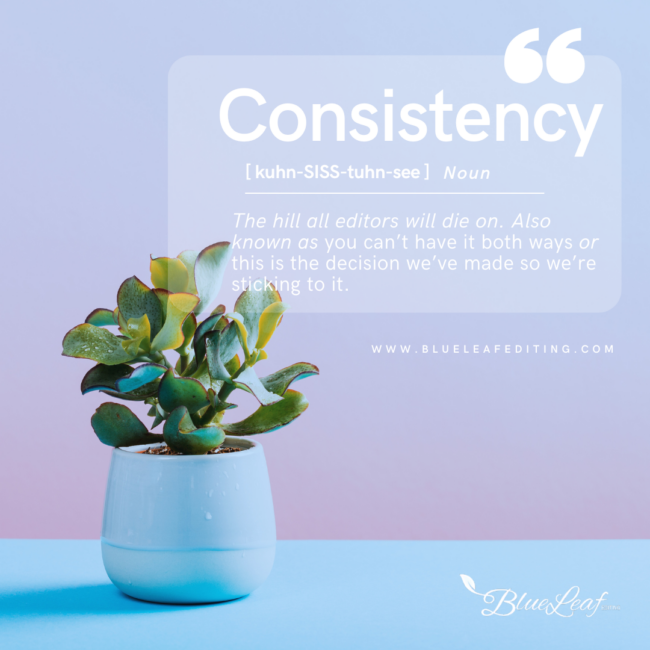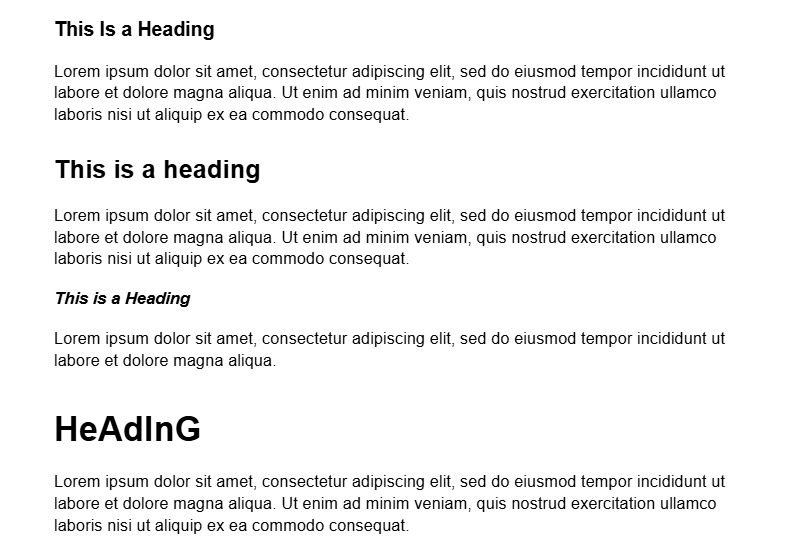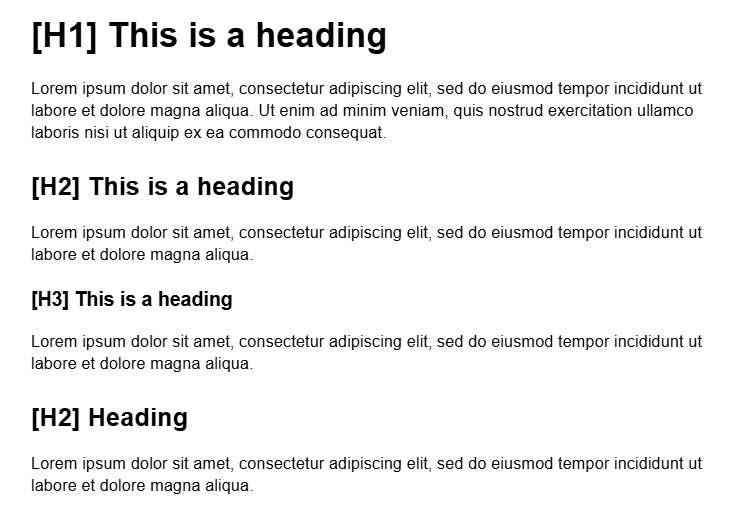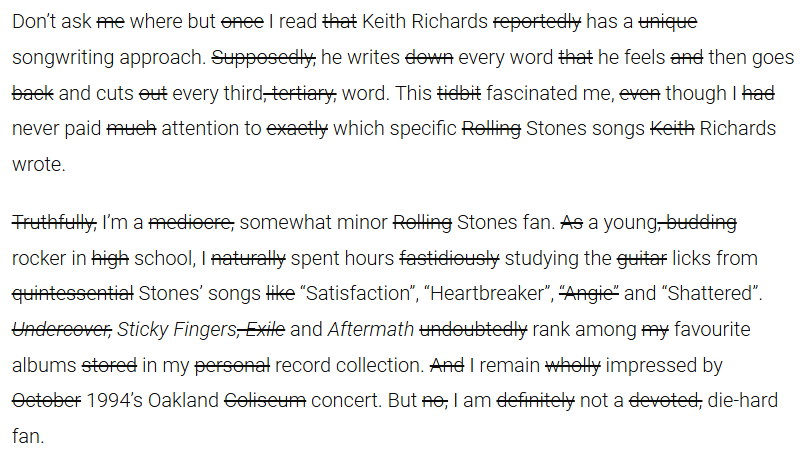Why Are Editors Always Harping About Consistency in Editing?

Consistency is the hill all editors will die on. Partly because that’s what editors are taught (think the 3 Cs of editing). But also because we can feel it in our bones. Consistency is woven into a text, giving it structure and direction. It’s the invisible hand that smoothes out the crinkles.
So, why do editors harp about consistency in editing? Because we can – and we must.
Table of Contents
What Does Consistency Actually Mean?
Before we get ahead of ourselves, let’s get on the same page about what consistency is. After all, the “what” will inform the “why”.
My trusty Oxford dictionary defines consistency as:
“The quality of always behaving in the same way or of having the same opinions, standard, etc; the quality of being consistent”
Well, no wonder authors and brands push back. Viewed like this, consistency sounds like a synonym for boring and predictable. No one wants to read that in a book or customer review.
Let’s try an editor’s definition from Butcher’s Copy-editing (2013):
“[Consistency] involves checking such things as spelling and the use of single or double quotes [...], either according to a house style or according to the author’s own style; checking the numbering of illustrations, tables and notes, and any cross-references to them, and also the consistency of bibliographical references.”
Yes, better. Now, we’re getting to the crux of the matter. Consistency’s “what” and “why” are similar: improving the text one nitty-gritty thing at a time.

What Consistency Is
Consistency is disciplined. It’s about making a stylistic choice and sticking to it. Do you like headings that are neon pink and toggle case? Yes? Oh…alright. Just make sure ALL your headings look like that, then.
Consistency is reliable. Especially when it’s linked to a style guide. Every writer and editor has heard that nagging voice asking, “Are you sure you didn’t miss anything?” A good style guide is like a consistency checklist, helping you tick every box.
Consistency is almost invisible when done correctly. There’s just something smooth about the text. It’s easy to navigate and understand.
What Consistency Isn’t
Consistency isn’t a killer. It’s not meant to be a damper that almost institutionalises creative writing.
Consistency isn’t boring. While it brings uniformity to a text, it doesn’t make everything the same. It shouldn’t make your writing just “another brick in the wall”. It should enhance the text’s technical cues (i.e. headings, lists, tables, figures, dialogue) to make it as easy as possible for the reader to comprehend the information.
Where Does the Need for Consistency in Writing and Editing Come From?
We’re hardwired to seek patterns. There’s a sense of control in knowing what to expect next. Whether this results in complacency or keeps us prepared is a philosophical debate for another day.
I know looking for patterns is the core of my editing methodology. And again, this isn’t meant to make text predictable. A pattern can be:
- The structure of a blog. Does the blog have a clear introduction, body, and conclusion? Do the ideas follow logically?
- Character names in a fiction manuscript. Why is Mr Wordsworth suddenly Mr Wentworth?
- Table or figure numbering. Does each chapter restart the sequence? Does it continue throughout?
- References in an academic text. Is it alphabetical or chronological? Do all the references use the same punctuation?
See what I’m getting at?
When readers encounter consistent grammar, writing styles, and formatting, they don’t have to focus so hard on deciphering the content’s structure. Instead, they pay attention to its message. That’s why an inconsistency can feel so jarring. It disrupts the brain’s pattern recognition process, breaking the immersion and potentially diminishing the reader’s trust in the content.
The Editing Process in (Consistent) Action
As with most things, examples help to clear up any haziness in understanding. Let’s look at three scenarios.
Scenario #1: When Authors Lean Too Much on Italics
Italics is a wonderful tool because it’s so versatile. You can use it for so many things…to the point of overuse. Consider this paragraph:
I can’t believe she thought, that he actually did this. How could he? She glanced down at the book in her lap, a well-worn copy of Pride and Prejudice, wondering if she could find solace in its pages. Across the table, he sat nonchalantly eating his croissant, like nothing had happened.
She wanted to scream: This is the last straw! Her mind whirled with questions: Does he even care? Why doesn’t he ever listen to me? She took a sip of her café au lait, struggling to keep her composure. Then, out of nowhere, he said, You’ll forgive me, won’t you?
A bit exaggerated, I’ll admit, but it gets the point across. The italics are used inconsistently and for different purposes:
- Internal thoughts (I can’t believe…How could he?)
-
- Foreign words (croissant and café au lait)
-
- Emphasis (This is the last straw!)
-
- Book titles (Pride and Prejudice)
-
- Direct speech (You’ll forgive me, won’t you?)
Instead of highlighting a specific section of the text for a specific purpose, most readers will wonder what’s going on. It looks like all of this information is important, but how are they supposed to sort through it and retain it?
Now, compare the paragraph with an edited version:
I can’t believe he actually did this, she thought. How could he? She glanced down at the book in her lap, a well-worn copy of Pride and Prejudice, hoping to find solace in its familiar pages. Across the table, he sat nonchalantly eating his croissant, like nothing had happened.
She wanted to scream, but instead, she forced herself to stay calm. Does he even care? Why doesn’t he ever listen to me? She took a sip of her café au lait, struggling to keep her composure. Then, out of nowhere, he said, “You’ll forgive me, won’t you?”
Better, yes? This is why the changes worked:
- Internal thoughts are in plain text. This eliminates unnecessary italics clutter.
- Foreign words like croissant and café au lait are unitalicised because they’re commonly used and accepted in English.
- Italics for emphasis is gone to let the character’s frustration come through naturally.
- Pride and Prejudice remains italicised because it’s the convention according to various established style guides.
- Dialogue uses double quotations to clarify that the words are spoken aloud.
Scenario #2: Keep Your Head(ings)
Headings are the signposts of content creation. They tell readers what’s to come, how information is grouped, and when a section ends. But not when you do it like this:

This is pretty self-explanatory, right? There’s no hierarchy. They don’t even use the same capitalisation. Breathe a sigh of relief with me when looking at the edited text:

Now, the text has a clear order (including consistent sentence case). The [H#] is just an illustrative extra to show the heading level.
Scenario #3: Getting to Number 1 (Or One?)
Numbers are tricky because you can either use a numeral (1) or write it out (one). There isn’t necessarily a right or wrong, but guess what? You have to consistently follow through on your choice. Look at this list of productivity tips:
- Wake up early to make the most of your day.
- Drink eight glasses of water daily.
- Sleep for 8 hours each night.
- Take three short breaks during work hours.
- Complete 2 major tasks before lunch.
Switching between numerals and words is distracting. You can even argue it creates an impression of carelessness. So, let’s fix it:
- Wake up early to make the most of your day.
- Drink 8 glasses of water daily.
- Sleep for 8 hours each night.
- Take 3 short breaks during work hours.
- Complete 2 major tasks before lunch.
This makes the list feel more cohesive and easier to skim. Alternatively, you can also consistently write out the numbers. However, there comes a point when that becomes impractical.
One million, three hundred and eighty-five thousand, six hundred and twenty-one looks much better as 1,385,621. So, to maintain consistency in editing, try these editing best practices:
- Use numerals for all numbers above 10 and for data, percentages, or measurements.
- Write out single-digit numbers (one to nine) unless part of a technical document or chart
Are There Any Exceptions to Consistency in Editing?
Of course. Sometimes, going rogue is more than just acceptable – it’s beneficial. If I can just break away for a quick side panel:
I think this trips up inexperienced editors (and when you try to explain editing to non-content people). A lot of editing decisions come down to “it depends”. Obviously, there are definite yesses and nos, but most of it is preference. So, consistency, yes, absolutely.
But also, in very specific cases, no. And it’s because of this intangible quality that I believe editing is a passion, an instinct. At the end of the day, a good editor does what’s best for the content. Even if it means breaking some rules.
Okay, let’s look at some exceptions.
When the Author’s Voice Takes Precedence
Every author has a unique style, and sometimes, rigidly enforcing consistency can dilute their voice. For example, an author may intentionally use incomplete sentences or unconventional punctuation for dramatic effect. A professional editor knows when to maintain the author’s stylistic choices to preserve their individuality, even if it bends standard rules.
A classic example is Emily Dickinson’s poetry:
I’m Nobody! Who are you?
Are you – Nobody – too?
Then there’s a pair of us!
Don’t tell! they’d advertise –
you know!
Her mixed capitalisation and reliance on dashes are far from conventional. But they pack a punch.
When Formatting Needs to Highlight Key Points
Certain types of professional writing, such as marketing copy or user manuals, may require breaking consistency to emphasise specific elements. Bold text, italics, or varied headings can draw attention where it’s most needed, even if they don’t align perfectly with the rest of the text.
For example:
- Key features might be bolded for skimmability.
-
- Technical terms could use italics for quick recognition.
-
- Numbers might stand out in a different font for emphasis.
When Context Demands It
Context often dictates how strictly you should apply consistency in editing. For example, academic papers demand precise adherence to style guides, but creative works or personal blogs can be more flexible.
Consider this blog that won the Writers’ College free writing competition in 2022, Writing With a Razor by Amelia Ray:

An editor would typically remove the deleted words from a final draft. However, in this case, it’s the whole point as the striked-out words emulate a razor.
So, still not sold on consistency in editing? Alright. Let’s wrap it up with one more “food for thought” piece: Consistency is bigger than editing.
Don’t Underestimate the Importance of Consistency
Ultimately, editors don’t harp about consistency in editing to be annoying or controlling. Remember, we have the same goal as writers: To create amazing content. Consistency is a proven way to do this. It gives structure where you need it and ups readability so much that readers can’t do anything but understand.
Because consistency doesn’t just mean all your headings are uniform or you’re using only UK English. Consistency also means you consistently deliver high-quality work. You consistently learn and improve. After all, what is success? The sum of consistent small efforts. So, be consistent. Every day.

Michelle Meyer
Michelle Meyer is the director and head editor of Blue Leaf Editing. With a background in publishing, bookselling, and marketing, she aims to turn all the content she edits into its best version. In her spare time, Michelle reads and watches as much horror and fantasy content as she can.
